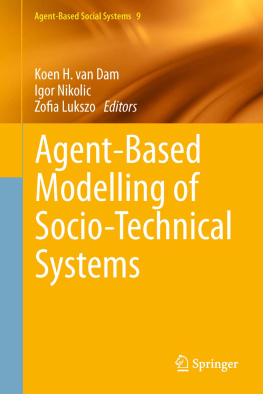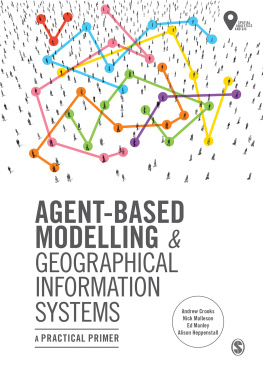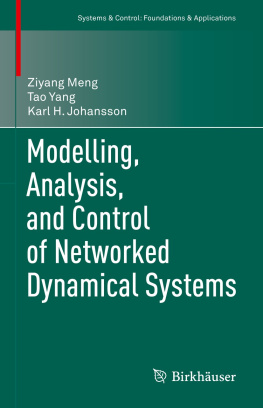1.1 Why This Book?
This book provides a comprehensive, hands-on introduction to agent-based modelling of socio-technical systems. Adopting a socio-technical systems view implies that we model parts of the man-made world (Allenby ).
This book is essentially about improving decision-making, in both the public and private arenas. This is important because the operation and the evolution of socio-technical systems are constrained by as well as driven by decisions. Improvement involves acknowledging the real-world complexity of such a system and experimenting with alternative strategies and institutions to discover their potential effects on the behaviour of the overall system before implementing them.
The primary intended audience of this book includes the actors that operate (large parts of) the socio-technical system, the actors that make large infrastructure investments, and the actors that draft new legislation and regulations. All of them are in need of a new way to see how their decisions, and all changes affecting user preferences, play out with regard to accomplishing public interests and private goals.
1.2 Infrastructures as Complex Adaptive Socio-technical Systems
Let us begin our description of socio-technical systems by discussing a typical example: the electricity infrastructure. The physical electricity infrastructure provides electric power; it contains millions of technological artefacts, such as wind and solar energy-harvesting facilities, thermal power plants, transmission lines, transformer stations and distribution networks. It is an open system, meaning that fuels and renewable energy sources are taken in, allowing electricity flows to be generated and transported, while heat, emissions and other waste products are dissipated into the natural environment. In terms of a social system, the electricity infrastructure involves many actors, ranging from power generators, transmission and distribution network operators, power suppliers, industrial users and consumers, to electricity market operators, traders and brokers, policy makers and regulatory authorities. The operational decisions and investment strategies of these actors are governed by institutions at the local level, by national legislation and regulation, and by supranational directives and agreements, such as the European directives on electricity sector reform and the Kyoto Agreement on the reduction of global carbon dioxide emissions. Some of the actors are multinational companies, but even the actors operating on a local or national scale are affected by supranational institutions and by decisions taken by other actors abroad.
The social infrastructure network can be decomposed into public and private actors, populating different segments of the value chain, at different hierarchical levels, and with different objectives and resources to reach their short-term and long-term goals. Depending on the research question at hand, we may want to formulate more detailed distinctions between actors, for example through grouping consumers by income, environmental awareness or other lifestyle characteristics. We could also conduct an in-depth exploration of their decision-making rules as set by, for example, market forces, the legislative and regulatory framework or the broader institutional context (de Bruijn and Herder ). Last but not least, we must recognise that the system is constantly in flux: the electricity infrastructure evolved over many decades, constantly being re-shaped by the decisions of many actors in response to changes in economic conditions, user demands, societal priorities and institutional frameworks.
The electricity infrastructure arrangement that dominated in the 20th century materialised because fossil resources, technology and economics favoured a vertically-integrated monopoly setup in which electric power is provided by relatively few large producers to many medium and small consumers. Enabled by technological advancement, driven by concerns about climate change, dependency on foreign oil and gas and increasing energy cost, and accelerated by the liberalisation and deregulation of the electricity market, in just a decade distributed generation has taken off, utilising a mix of both fossil and renewable resources. Combined with the ongoing reregulation of the electricity sector, this has created both short-term and long-term uncertainty and has forced network operators, power companies, and industrial producers and consumers to carve out and redefine their niches in the power sector ecosystem. Today consumers produce their own power, institutional investors and green energy collectives build wind parks, and greenhouse operators and a host of other actors leverage small- to medium-scale generation technologies such as wind turbines, photovoltaics and (micro) combined heat and power.
It is thus apparent that within a changing institutional framework, the system is self-organising in a process that co-evolves with the web of institutions and regulations. This process of self-organisation occurs at multiple levels: the system is composed of national, regional and local subsystems including generation, transmission, distribution and loads. With an increasing share of generation capacity from wind farms, and because an increasing number of power consumers can switch roles to become power producers (so-called prosumers), the amount and the quality of power produced in such a decentralised system can vary enormously. The number and types of links in the electricity infrastructure system are continuously increasing, each and every link potentially affecting the real-time integrity of the grid and its long-term evolution. The shift from centralised to decentralised power generation, the adoption of small-scale renewable power generation units, the introduction of electric vehicles and the implementation of smart grids are some of the prominent developments that dramatically affect the structure and behaviour of the electricity infrastructure, in both the technical and social dimensions.











